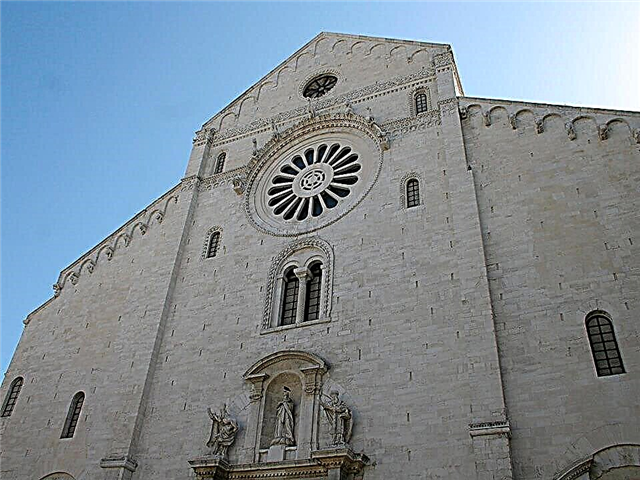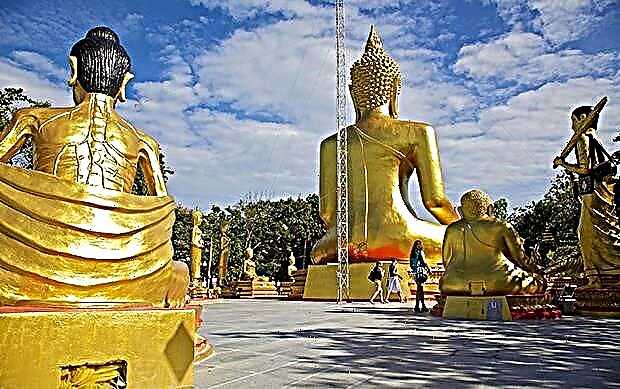Only one of the posad temples in Sviyazhsk has survived. All other churches belong to two monasteries - the Virgin of the Assumption and St. John the Baptist. A modest white temple-"ship" stands on a high coastal terrace and dominates the rest of the building of the island-city. A high bell tower, gilded onion domes and openwork crosses look beautiful both from the bank and from the river.
Temple history
In 1551, before the decisive assault on Kazan, John IV the Terrible ordered to build a fortress in Sviyazhsk. In addition to a wooden fort and barracks for soldiers, the first parish church was erected in the new settlement. According to legend, the place for it was chosen by the Russian sovereign himself. When the small wooden church was completed, it was dedicated to the Equal-to-the-Apostles Kings Constantine and Helen.

View of the Church of Saints Constantine and Helena from Moskovskaya Street
It is known that the first priest of the temple was Father Herman, who created Sviyazhskaya Theotokos-Assumption male monastery... In 1564 the high priest of the city took the title of archbishop and moved to Kazan.
The earliest record of the Sviyazhsk church dates back to 1568. 17 years after its foundation, it was mentioned among the nine parish churches of Sviyazhsk in the scribal book. An ancient document preserved a record that the church stood "on the square, opposite the large Christmas gate."

View of the Church of Saints Constantine and Helena from Bolotnaya Street
In the middle of the 16th century, all city buildings were made of wood. Over time, the church decayed and it was decided to replace it with a stone one. It is believed that the new temple was built at the end of the 17th or the beginning of the 18th century. Then the bell tower stood separately from the building.
The temple had three thrones. The main one was dedicated to Constantine and Helen, the southern one - to the Christian theologian and preacher Andrey of Crete, and the northern one - to the Bishop of Rostov and Suzdal Leonty. In the parable, there were three priests, a malt service, a sexton and a church watchman. All of them received a cash and grain salary from the treasury, so the church was "ruzhny".

View of the Church of Saints Constantine and Helena from the Volga
She was on the border of the city. From the west of the temple, the Sviyazh fortifications rose, and below was the posad, where the workshops of artisans and houses of the bourgeois stood. At the beginning of the 18th century, the building acquired a modern look - the bell tower and the main volume were connected by a squat refectory, and in 1855 the temple was assigned to the main city cathedral.
In the late 19th and early 20th centuries, the Sviyazhsk church flourished. With the money of the diocese and benefactors, two side-chapels and a chapel on the south side were built. It is known that the local merchant N.I. Savrasov. Two thrones were consecrated in the church - in honor of George the Victorious, the icon of the Vladimir Mother of God and Constantine and Helena revered by believers.

View of the entrance and bell tower of the Church of Saints Constantine and Helena
With the advent of Soviet power, the situation changed. In all parts of the state, including Kazan, religious organizations began to actively oppress. Despite the policy of atheism pursued in the country, the Church of Sviyazh was not touched for a long time. Then the north side-chapel was lost, and in 1929 a small chapel was destroyed.
Temples and monasteries of the diocese disappeared one after another. Many buildings were blown up and dismantled for building materials, and people came to the services in the old church without hindrance. This continued until 1939, when the rector Priest Anatoly Romanovsky served the last prayer service. After that, the Sviyazhsky temple was closed.

General view of the Church of Saints Constantine and Helena
At first, a solid stone building was converted into a smithy, and then - into a warehouse. In the 1980s and early 1990s, the former temple was considered a branch of the State Museum of the Tatar Autonomous Soviet Socialist Republic, therefore, museum expositions were housed inside, and exhibitions were held.
Finally, at the request of the Christian community of Sviyazhsk, the building was returned to the Church. After a long break, in early June 1993, the first divine service was held.

Parishioners, volunteers and builders have begun a large-scale restoration. In 1994, when clearing the territory from the north of the church, two graves were found with many human remains. The innocent victims were reburied in a common grave, and a large worship cross was erected over it.
Architectural features
The old church is rightfully considered one of the landmarks of the Republic of Tatarstan. After the tall Nativity Cathedral was destroyed in the 1930s, it became the compositional center of the eastern part of the island. Snow-white walls and shiny domes are eye-catching! A particularly splendid view of the temple opens up to everyone who gets to Sviyazhsk by water.

Worship cross at the burial site
The brick building was erected in the best traditions of Russian temple architecture of the late 17th - early 18th centuries. The three-part pillarless building - "ship" consists of a temple part, a refectory and a bell tower, which are stretched in one line - from east to west.
The laconic quadrangle of the church has box and tray vaults. Above it rises a deaf drum with a neat bulbous head. A three-bladed apse adjoins the building from the east. Since the temple stands on a slope, the apse is below the main volume.

The low one-storey refectory has box vaults and a gable roof. A beautiful three-tiered bell tower stands to the west of it. The two lower tiers look like fours. Above, there is an octagon of the belfry with arched openings, and the building is crowned with a low spherical dome and a deaf drum with a gilded onion dome.
The decoration of the church traces the traditions of ancient Russian stone architecture and baroque elements. Semi-columns and pediments on the window frames are stylized as cockscombs, and the cornice is decorated with brackets in the form of steps.

Baptismal view
To the north of the temple is a small baptismal, which appeared in 2010-2012. An elegant chapel is visible from the south, designed by the architect E.V. Ignatiev with money from the Renaissance charity foundation. The chapel is made in the style of the temple, so they perfectly complement each other. A small area is surrounded by a low fence on stone pillars.
Interiors and shrines
Inside, the church is very cozy, and you immediately feel at home in it. In the eastern part there is a three-tiered iconostasis. Most of the icons are new. Some were written by Father Sergius (Korobtsev), who has led the local community since 1995.

The most ancient icon is the "Lord of hosts", which art historians date back to the 18th century. There are several 19th century icons in the church. Believers come here to pray in front of Orthodox shrines - the Sviyazhsk icon of the Mother of God, the image of Sergius of Radonezh, revered in Russia, and an icon with a particle of the relics of St. German of Kazan.
Useful information for pilgrims and tourists
Today the old church is active. Here they confess, marry, baptize and see off on their last journey. Children from Sviyazhsk attend Sunday school. Locals call their favorite parish church Tsarekonstantinovsky or Konstantinoeleninsky.

The interior of the Church of Saints Constantine and Helena
The doors of the church are open to everyone from morning to evening. Services are held on Sundays and public holidays at 8:00 and 16:30, and in winter - at 9:00 and 15:00. The feast day in the temple is celebrated on July 11.
How to get there
The attraction of Sviyazhsk is located on the northeastern tip of the island. The temple stands 150 meters from the coast, at the crossroads of Konstantinovskaya, Uspenskaya, Moskovskaya and Bolotnaya streets. If you are arriving by car, from Kazan you need to take the M-7 highway towards the Russian capital.At the roundabout, after the automobile bridge over the Sviyaga river, turn right at the Sviyazhsk signboard, and after 11.5 km you will be on the spot.

Iconostasis of the Church of Saints Constantine and Helena
The island has the status of a museum-reserve. Unauthorized cars are not allowed there, so you need to park in a guarded parking lot before entering Sviyazhsk. Walk along Uspenskaya Street, and after 1 km it will lead you to the temple.
In summer, during the navigation season, it is convenient to sail from Kazan to the island by boat. The journey by water takes two hours. The church is located within walking distance from the Sviyazhsk river station.
Attraction rating:











